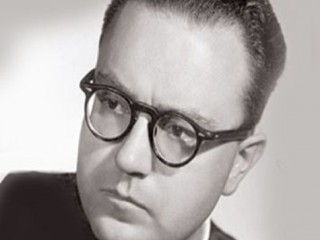
Alberto Ginastera biography
Date of birth : 1916-04-11
Date of death : 1983-06-25
Birthplace : Buenos Aires, Argentina
Nationality : Argentine
Category : Arts and Entertainment
Last modified : 2010-11-15
Credited as : Composer of classical music, ,
The composer Alberto Evaristo Ginastera employed both national idioms of his native Argentina and a variety of avant-garde techniques in developing a unique style.
Of Spanish-Italian ancestry, Alberto Ginastera was born in Buenos Aires on April 11, 1916. At the age of five, he became frustrated when he was unable to play his country's national anthem on a toy flute, because the instrument's range was too narrow. His musical talent was recognized early on, and he entered the Williams Conservatory in Buenos Aires to study music at age 12. He graduated from the National Conservatory of Music with honors in 1938, and three years later he returned to the conservatory as professor of composition. Ginastera set extremely high standards for himself, destroying some of his early compositions because he wanted to be remembered only for his best work.
In his early years, Ginastera was not widely known outside Argentina, and even there, his political views sometimes got him into trouble with the country's leaders. The composer was particularly critical of the country's military governments, which he felt inhibited artistic expression. Twice, he was forbidden to teach, even at a music school he had founded, the Conservatory of Music and Scenic Arts at La Plata.
Ginastera's three Danzas argentinas for piano and the one-act ballet Panamba date from 1937. A second ballet, Estancia (Ranch), was commissioned by the American Ballet Caravan in 1941. His first symphony, Sinfonia portea (1942), established him as a leading Latin American composer.
During an extended stay in the United States on a Guggenheim fellowship Ginastera's Duo for Flute and Oboe (1945) was premiered. Returning to Argentina, he organized in 1948 the Conservatory of Music and Scenic Art of the province of Buenos Aires. Later he became dean of the faculty of arts and musical science of the Catholic University of Argentina. In 1962 he was named director and professor of composition at the Latin American Center for Advanced Musical Studies in Buenos Aires.
Ginastera was early identified with musical nationalism. Such works as Overture for the Creole Faust (1943), Pampeana No. 1 for violin and piano (1946), Pampeana No. 2 for cello and piano, Pampeana No. 3 for orchestra (1954), as well as his piano pieces and Argentine songs, reflect national characteristics.
However, the First String Quartet (1948) and the popular Variaciones concertantes for chamber orchestra (1953) are more formal and nonassociative. The Sonata for Piano (1952) employs polytonal and twelve-tone techniques. Extensive serialism is found in the extraordinarily difficult Violin Concerto (1963) commissioned for the opening of Philharmonic Hall at Lincoln Center. With the opera Don Rodrigo (1964) and the cantata Bomarzo (1964), commissioned by the U.S. Library of Congress, he emerged as one of the leaders of the avant-garde, making effective use of microtones, aleatory passages, and electronic effects.
Most of Ginastera's major works were commissioned. These include the Second String Quartet (1958), Piano Concerto (1961), Concerto for Harp and Orchestra (1965), and the Cello Concerto (1968). The Juilliard String Quartet performed his Second String Quartet in 1958 at the International American Music Festival in Washington, D.C. This was the first major serial composition from Ginastera and did much to establish his international reputation. Critic Howard Taubman said Ginastera created "an original and exciting synthesis of contemporary trends … employing polytonality, serial technique, and a variety of novel timbres with compelling naturalness." Aside from the perseverance of certain Argentinian rhythmic patterns, there is little that might be labeled either traditional or ethnic in the composer's mature works. They established him not only as a master craftsman of great originality but one uncommitted to any particular "school" of contemporary music.
Ginastera's second opera, Bomarzo made headlines upon its international debut in Washington, D.C., in 1967. Like the composer's first opera Don Rodrigo, it was atonal, but there the resemblance ended. The story line for the second opera was based on the final 15 seconds of life of the Duke of Bomarzo and featured scenes of sex, voyeurism, impotence, violence, and nudity. The opera was a stunning success in the United States, but Argentina banned its performance in that country until five years after its U.S. premiere, citing the composer's "obsession" with sex.
Ginastera often found inspiration in literature for his musical works. His cantata for soprano and orchestra, Milena was based on the letters of Franz Kafka, while Pablo Neruda supplied the text for another vocal work called Serenata. Of the importance of the classics of art, literature, and music to his own work, Ginastera once said, "I think that when an artist feels lost with too much speculation, he should re-read the works of Shakespeare, look at Fra Angelico's paintings or listen to Beethoven's symphonies, and then I am sure he would return to the right path."
Ginastera first married in 1941, wedding Mercedes de Toro. Their marriage ended in divorce in 1969 and produced two children, Alejandro and Georgina. In 1971, Ginastera married again, this time to Aurora Natola. The couple moved to Switzerland shortly after their marriage, but the move did little to alter the basic character of Ginastera's music. In 1980 his symphonic piece Iubilum, written to mark the 400th anniversary of Buenos Aires' founding, was first performed. Three years later in Geneva, Ginastera died at the age of sixty-seven on June 25, 1983.
A doctoral dissertation by David Edward Wallace, Alberto Ginastera: An Analysis of His Style and Techniques (1964), is available in duplicated book form. David Ewen, World of Twentieth Century Music (1968), has a short biography of Ginastera and a valuable analysis of 11 compositions. Otto Deri, Exploring Twentieth Century Music (1968), evaluates the composer's contributions. Suggestions for further investigation are in Gilbert Chase, A Guide to the Music of Latin America (1945; 2d ed. rev. 1962).
















